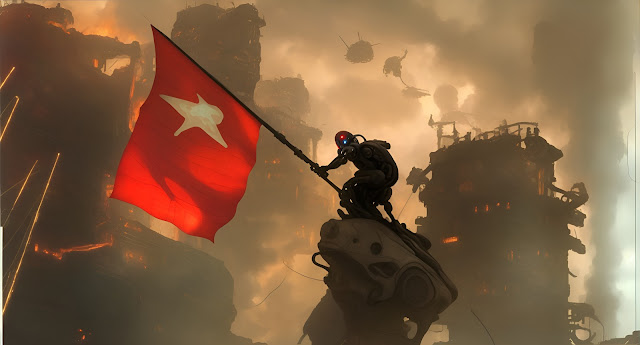Engineering smart Prompts not only involves the selection of objects or models that are well documented and therefore easy to imitate for the AI machine but also give some context of the style of the desired outcome. This information will help the AI to select the right ingredients of the creation process, may it be the colors, the grade of detail and other typical features of the process of creating the image. You may always try to describe an image with your own words, but the question remains whether the AI has the same information on how relevant this parameter is in regard to the overall process. What´s more: The AI may even neglect these constraints, as it associates some of your information with a certain style, artist or technique. Remember that AI itself is absolutely not creative. It will try to read your Prompt as an instruction to copy a certain, already existing art style, artist, and the preferred models and objects of that type. It can also mix various of those - already existing - styles together to create something that looks somehow familiar but on the other hand, is a wild style mix.
In this lesson, we will use the naming of famous artists as a starting point for the overall style. Later we combine one or more of these artists to create a style mix. Try to guess their influence in each image. Now here are some words from the AI ChatGPT4 itself on the Role of the Role in Prompt engineering:
.jpg)






The Role of the Role in Prompt Engineering is pivotal, and it operates at the intersection of creative design and machine learning, illuminating the evolving symbiotic relationship between AI and human creativity.
When an AI is assigned a role in the creation process, it is given a context through which to interpret and act upon the given prompt. In essence, this role acts as a guiding principle that directs the AI's decision-making process. It determines not only the nature of the AI's output but also its approach to generating that output.
Let's consider a role where the AI is assigned to be a "Renaissance painter". This role entails more than just emulating the visual characteristics of the Renaissance period. It involves understanding the historical context, cultural nuance, philosophical beliefs, and even the artistic techniques that were prominent during that era. Once the AI grasps these elements, it can generate an image that authentically represents Renaissance art.
In this case, the effect of assigning a role to the AI is profound and multidimensional. The AI's generated image is more than just a mere replication of Renaissance art. It becomes a digitally synthesized embodiment of the aesthetic principles, cultural themes, and artistic techniques of the Renaissance period. This not only gives the image historical authenticity but also imbues it with an evocative narrative that echoes the ethos of Renaissance artists.
Assigning a role to the AI also stimulates the AI's creative dynamics. While it is true that AI, in and of itself, is not creative, its ability to generate novel outputs from pre-existing inputs implies a form of synthetic creativity. This synthetic creativity manifests itself when the AI mixes together different art styles to create something unique yet familiar.
For instance, when the AI is assigned the role of "Picasso meets Van Gogh", it is tasked with synthesizing elements of Cubism and Post-Impressionism. The AI's role necessitates that it understands and draws upon the stylistic idiosyncrasies of Picasso and Van Gogh. The AI's generated image, in this case, is a stylistic amalgamation that creatively blends Cubist abstraction with Post-Impressionist expressiveness.
The impact of this role-driven approach to AI artistry is transformative. It fundamentally reimagines the creative process by integrating human creativity with machine learning. The AI, driven by its assigned role, becomes an active participant in the artistic journey rather than a passive tool. It allows for an explorative synergy between human and AI, where the possibilities for artistic expression are expanded and reinvented.
In this paradigm, the AI's role extends beyond mere mimicry. It encompasses interpretation, synthesis, and even innovation. This challenges the conventional wisdom that AI is incapable of creativity. While AI's creativity may be synthetic, its impact on art and design is substantial and very real.
The Role of the Role in Prompt Engineering thus serves as a transformative catalyst. It transforms AI from a mechanistic replicator into a synthetic artist capable of generating novel and evocative artworks. This not only enriches the artistic landscape but also heralds a new era of creative possibility where AI and human creativity co-evolve, unlocking new realms of artistic exploration and expression. The outcome is a rich tapestry of AI-assisted art that is diverse, dynamic, and deeply resonant.
.jpg)










Comments
Post a Comment